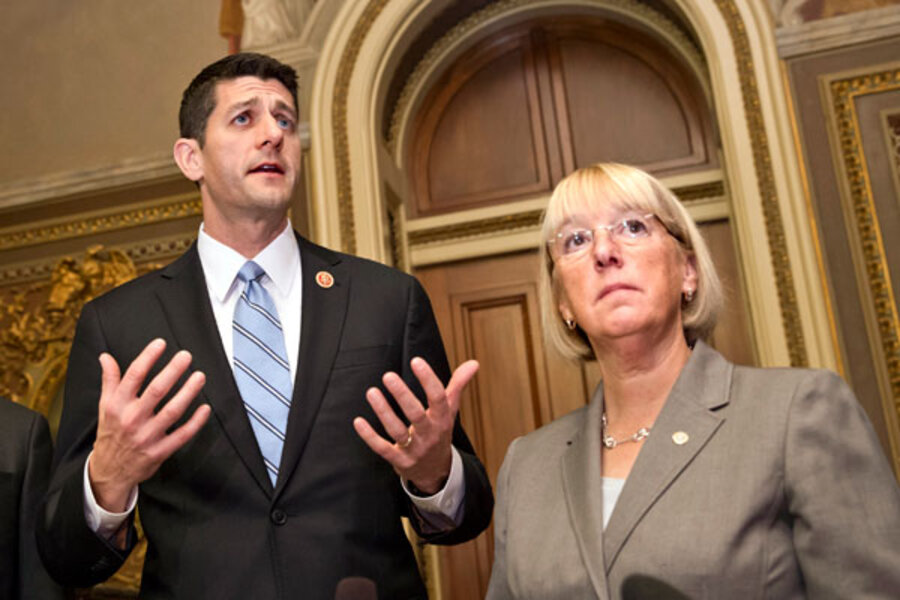How Congress's odd couple reached a remarkable budget deal
Loading...
| Washington
Rep. Paul Ryan (R) of Wisconsin and Sen. Patty Murray (D) of Washington could hardly be more unlike.
Representative Ryan is the conservative wunderkind who could have been the vice president of the United States by now. Senator Murray is the former preschool teacher who works quietly behind the scenes and once basically ran the Senate Appropriations Committee for Robert Byrd, the powerful Democrat from West Virginia, when he was ill.
Ryan is Captain Cutback – the man whose vision for reforming Medicare and Social Security make Murray shudder right down to the soles of her sensible shoes. In fact, Murray reportedly advised her close ally, Senate majority leader Harry Reid (D) of Nevada, not to accept a compromise with Republicans during the October government shutdown, worried that the deal would involve too much of a hit to safety-net programs.
Stand them next to each other, and Murray comes up to about shoulder-height on the tall, athletic Ryan.
As Murray put it, somewhat humorously as they stood head-to-shoulder at a Tuesday press conference: “We cheer for a different football team. Clearly. We catch different fish.”
Yet this congressional odd couple is responsible for producing a budget deal that could keep the federal government running for two fiscal years. The deal, announced Tuesday, is nothing approaching a "grand bargain." In fact, it is about the un-grandest bargain imaginable, which has left some conservatives fuming.
But the last time that a divided Congress was able to forge a budget agreement was 1986. Even a modest agreement such as this one is remarkable, says G. William Hoagland, who served as a budget director to former Senate majority leader Bill Frist (R) of Tennessee.
It helped that Ryan and Murray, leaders of the House and Senate budget committees, have talked a lot this past year, meeting often for budget discussions in Murray’s “hideaway” office between both chambers. Talking sounds basic, but in this Congress, it’s by no means a given.
It helped, too, that both budget leaders are pragmatists, and that neither one wanted to see the country thrown into turmoil with another government shutdown on Jan. 15, 2014. That’s when the budget fix to the October shutdown was set to expire.
And pragmatism is the watchword of this budget deal, which literally splits the difference between what the Democratic-held Senate and Republican-held House wanted.
Discretionary spending is set at $1.012 trillion for this 2014 fiscal year – about half way between the Senate budget of $1.058 trillion and the House’s $967 billion. Automatic, across-the-board spending cuts – the “sequester” that was criticized by many Republicans for its damage to the Pentagon and by Democrats for its harm to social programs – is partially lifted, with the gains evenly divided between defense and nondefense spending. A tiny trim has been made to the deficit.
“One would have thought that there was just no way on God’s green earth that with Mrs. Murray’s liberal rating and Paul’s very conservative rating that they would come to any kind of agreement,” says Mr. Hoagland, who is now at the Bipartisan Policy Center think tank.
It turns out they had more to talk about than just the great outdoors. (Murray likes to go salmon fishing to clear her mind; Ryan is an avid bow-hunter.)
At the start of their negotiations, which began eight weeks ago, they acknowledged what was not possible. They knew that Republicans would not give on raising taxes and Democrats would not give on changes to Medicare and Social Security without more tax revenue. So the two budget leaders – yes, there was a committee of 29 appointed, but the work was done by Ryan and Murray – decided to focus on the common ground.
It turned out to be a small patch.
You could hear the pragmatism in Ryan’s voice Wednesday morning as he defended the deal before reporters in the Capitol. A question was asked about conservatives who oppose the agreement (they see it as too easy on the sequester and not tough enough on the debt).
“Look, as a conservative, I deal with the situation as it exists,” said Ryan. “I passed three budgets in a row that reflect my priorities and my principles” and none of the budgets passed the Senate. “We're in divided government…. So I'm not going to go a mile in the direction I want to go to, but I will take a few steps in the right direction.”
Ryan and Murray kept key players in both of their houses informed and believe their agreement will pass both the House and the Senate in the coming days, despite some opposition. Both lawmakers are convinced that the restoration of even a semblance of normalcy in the budgeting process will bring more certainty to Washington and thus help boost the economy – and perhaps even pave the way for compromise on bigger issues.
“What this budget agreement does is it helps produce more certainty because it stops a potential government shutdown,” Ryan emphasized this morning.
Avoiding more chaos, on both sides, appears to have been the biggest motivator of all.








